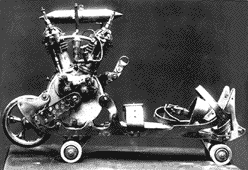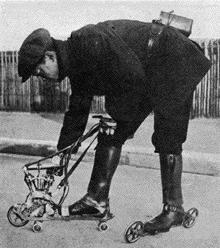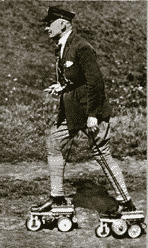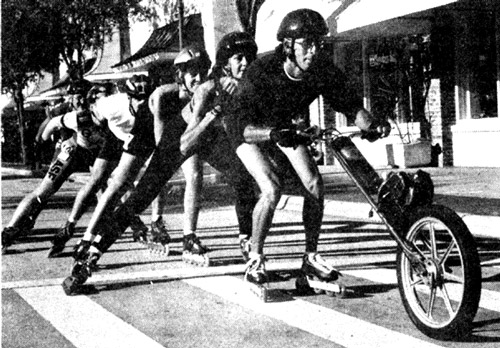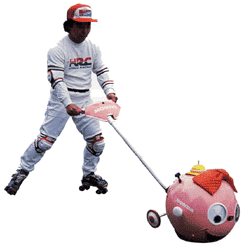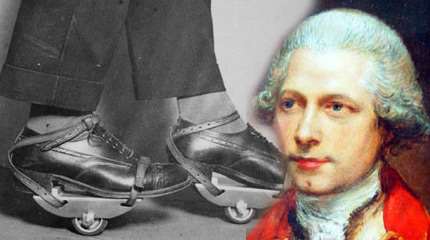Motor-Skates throughout History
Inventors never run out of ideas and skating has made its way through time decked out with more or less useful or strange means of motorization. OLS offers you a travel in time with that article by Sam Nieswizski, our skating historian…
Par alfathor
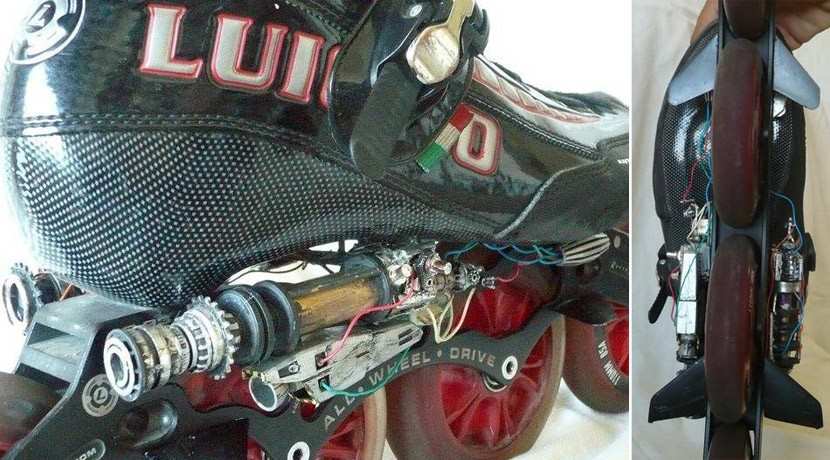
Motorized skates
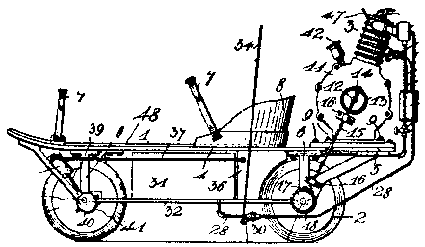 Machine motorization became widespread at the end of the 19th C. / beginning of the 20th C. with the development of gas engines.
Machine motorization became widespread at the end of the 19th C. / beginning of the 20th C. with the development of gas engines.
Automobiles supplanted horse-drawn vehicles, and two-wheeler riders could enjoy motorcycles.
When inventors tackled the problem of skate motorization, they had to take up new challenges: miniaturizing motors and imagining original and specific solutions.
1905: The first motor-skates
History started on October 1905. American Henry Beauford of Kansas City patented the ‘utomobile skate, the frame of which, extended in the rear, supported a petrol engine.
Beaufort’s automobile skate >>
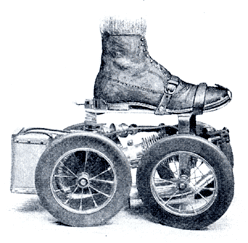 Shortly afterwards, French Constantini exhibited his Patin Automobile at the December 1905 Motor Show. The skates totaled a 24 cm ground clearance, the solid tires had a diameter of 18 cm and the pair weighted 12 kg. The four-stroke engine consumed 1.5 L per 100 km and enabled the skates to reach a top speed of 55 kph. The petrol tank and the battery were fixed at the skater’s belt.
Shortly afterwards, French Constantini exhibited his Patin Automobile at the December 1905 Motor Show. The skates totaled a 24 cm ground clearance, the solid tires had a diameter of 18 cm and the pair weighted 12 kg. The four-stroke engine consumed 1.5 L per 100 km and enabled the skates to reach a top speed of 55 kph. The petrol tank and the battery were fixed at the skater’s belt.
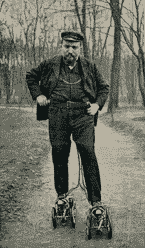 In order to slow down or stop, you had to play with the ignition delay, turn the engine off or put your weight on your front wheels, since the skates had a rear-wheel drive. They costed 450 Francs (around 2000€) and met such a success that the Shah of Persia ordered three pairs!
In order to slow down or stop, you had to play with the ignition delay, turn the engine off or put your weight on your front wheels, since the skates had a rear-wheel drive. They costed 450 Francs (around 2000€) and met such a success that the Shah of Persia ordered three pairs!
1906: Destination USA
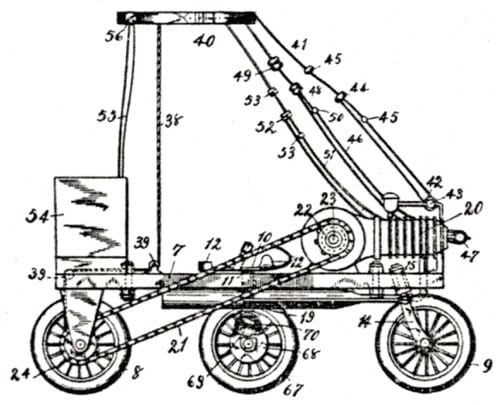 The following year, Charles Matson of Chicago designed a three-wheel inline skate, the engine of which, placed at the front of the foot, activated the rear wheel with a chain.
The following year, Charles Matson of Chicago designed a three-wheel inline skate, the engine of which, placed at the front of the foot, activated the rear wheel with a chain.
Matson’s skate >>
1907: Ideas germinate in Switzerland too
Swiss Koller of Winterthur invented a very original mono wheel Patin de Route (road skate) in 1907. The engine was fixed just above the wheel and the foot was placed on some kind of pedal. As for the wheel, it was placed on the outside of the foot and was tilted so that its contact point with the ground was perpendicular to the axis of the foot.
1912: Made in France
French Mercier designed a curious skate in 1912. Contrary to his predecessors, he motorized only one skate of the pair. The two-cylinder four-stroke engine developed a power of 1.25 hp and enabled to go at a 30 kph speed.
|
|
|
1924: Germany
In 1924, German Hans Gebhardt of Munich had an original idea: he used acetylene as fuel, commonly used at the time for lights or as heat source for blowtorches. The skater could reach a top speed of 30 kph.
I cannot resist the pleasure of mentioning another amusing invention by Gebhardt, although it is not a motor skate: he designed a cable driving a flywheel connected to the skate wheels, meant to reduce the skater’s efforts.
|
|
|
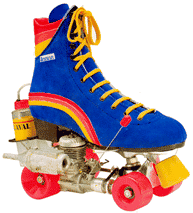
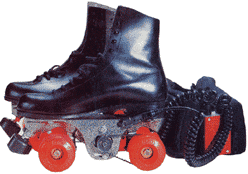
A flywheel skate
A long break followed and motor skates only resurfaced in the 1980’s.
The American skate, made in Lyon although not suggested by its name, was equipped with a 15 cm3 two-stroke engine going up to 30 kph.
An electric motor skate
The Hammacher Schlemmer company of Chicago manufactured the first non-polluting motor skate: Four 6V rechargeable batteries fixed at the skater’s belt would supply power to the electric engine, which would develop a power of 1/3 hp, a speed regulated by a potentiometer and reaching 34 kph. The batteries needed seven hours to be recharged.
The last-born, designed by American Tim Gandle, was an inline skate called the Motoskate. Only one skate out of the two was motorized for a top speed of 60 kph.
Motor skis
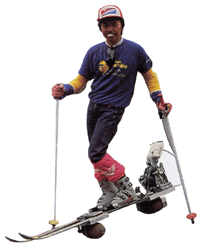 Let’s close this overview with probably the most harebrained invention of all: urban motor skis.
Let’s close this overview with probably the most harebrained invention of all: urban motor skis.
1956: An engine on the skater’s back
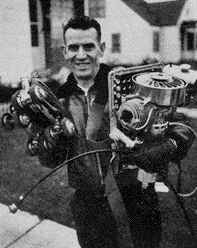 Motorizing skates requires a miniaturization that is not compatible with the power needed. Some inventors had the idea of placing the engine… on the skater rather than on the skate. That revolutionary concept goes to American Anthony Pirrello of Detroit, a mechanic at General Motors. Around 1956 he designed a petrol engine that would be carried by the skater like a backpack. The engine would drive one of the skates with a flexible cable and would enable to reach 65 kph.
Motorizing skates requires a miniaturization that is not compatible with the power needed. Some inventors had the idea of placing the engine… on the skater rather than on the skate. That revolutionary concept goes to American Anthony Pirrello of Detroit, a mechanic at General Motors. Around 1956 he designed a petrol engine that would be carried by the skater like a backpack. The engine would drive one of the skates with a flexible cable and would enable to reach 65 kph.
But the weight of the engine was quite a drawback. in 1980 germinated the idea of a towing set for skaters, composed of an engine activating a wheel, and a handlebar for the skater to hold on.
The American Motormutt
The Motormutt was made in USA. The wheel, similar to a bicycle wheel, was activated by a 49 m3 two-stroke engine. Japanese company Honda made an equivalent two-wheeled system.
|
|
|
The 1980’s: the Roll’Ex

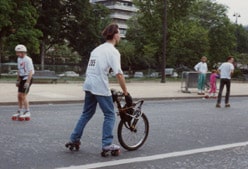 The Roll’Ex was born in France. It was the front part of a Vélosolex (a motorbike which met a great success in the 1950’s). The Roll’Ex was made up of a handlebar supporting a two-stroke engine which would directly activate a wheel with a roller. in 1989, a group of skaters planned a long-distance course entitled “Trans Europe en Roll’Ex”, starting from Couëron near Nantes, crossing Norway, Sweden, Denmark, Germany, the Netherlands, Luxembourg, Belgium, England then back to France and finishing in Spain (I don’t know if the project actually took place).
The Roll’Ex was born in France. It was the front part of a Vélosolex (a motorbike which met a great success in the 1950’s). The Roll’Ex was made up of a handlebar supporting a two-stroke engine which would directly activate a wheel with a roller. in 1989, a group of skaters planned a long-distance course entitled “Trans Europe en Roll’Ex”, starting from Couëron near Nantes, crossing Norway, Sweden, Denmark, Germany, the Netherlands, Luxembourg, Belgium, England then back to France and finishing in Spain (I don’t know if the project actually took place).
In the 1980’s was also designed a dorsal propeller engine for skaters, boarders and bicycle riders.
Jet Roller
The last-born skating motor is the Jet Roller, designed by Mike of Wattignies. The engine, from 26 to 52 cm3, activates a wheel linked to a tube and a handlebar. Original solution: the tube is used as a fuel tank. The skater can be towed or pushed at up to 40 kph.
2007: The customized Skorpions
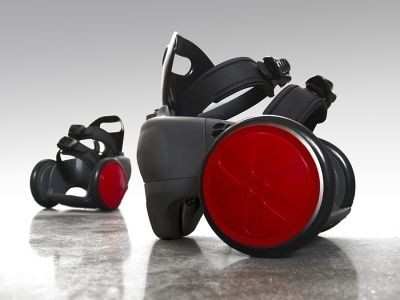
The Skorpions, skates with an axle design, were equipped with an engine propelling them up to 30 kph to create the iShoes. See article and video here.
2010: From chainsaw to wheels
In 2010, an inventor created skates with a chainsaw engine that could go up to 60 kph for fun. See the video here.
That same year, a Coyote skater opted for a motorized handlebar to propel himself. See the video. The Fly Rad follows the same spirit too.
2011: SpnKIX the electric skates
The concept is a bit more ecological but remains pretty cumbersome. That invention was created by American Peter Treadway. Those skates can reach 10 mph (16 kph) with a battery life of (only) 4 km. We had introduced them here.
And then?
The least to say is that inventors have vivid imagination… and that there are probably a lot more surprises to come. When will jet motor-skates see the light? What about atomic motor-skates?
Useful links
Photos: all rights reserved

